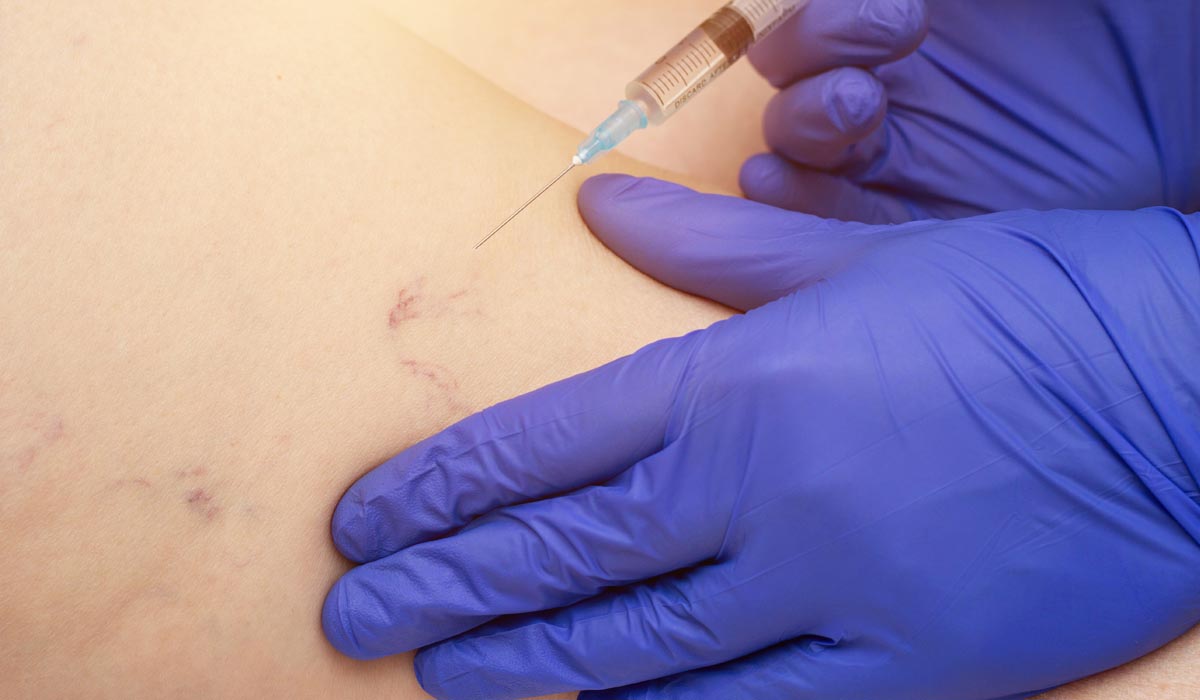✨Book online and enjoy a 5% discount on your first consultation
Home » Plastic Surgery Services » Sclerotherapy


Medical Service Name – Sclerotherapy
Varicose and spider veins are unsightly and displeasing problems due to the fragile vein walls and can be painful in some cases. The weak vein valve results in blood pooling in the capacitance vessels that may cause the bulging issue in the feet or legs. Whether you suffer from leg cramps or swelling, sclerotherapy is an effective and standard treatment to cure varicose veins. It involves injecting a solution called Sclerosant directly into the lymph vessel. As a result of this process, it forces the blood to flow through healthier lodes, and local tissue reabsorbs the collapsed arterioles to lighten the scar. Eventually, it takes a few weeks or months to reduce the pain and shrink the capacitance vessels.
Additionally, sclerotherapy is also considered for some other issues:
Possible Causes
Arteries control blood flow from the heart to the rest of the tissues, whereas veins return blood to the heart to ensure smooth flow. The veins in the legs must function correctly for this mechanism to work. Backward flow and blood accumulation in your legs occur when your blood valves become weak.
As you become older, you’ll notice that you’re having more of these problems. Obesity and excess weight can also trigger this problem. Including that, hormonal changes during menopause or pregnancy might be a factor that intensifies this vein disorder. It wears and rips the valves, causing blood to pool and stopping the circulation process. People undergo this therapy to heal the damaged valves that may lead to varicose veins.
Risk Factors
Sign & Symptoms
Not everyone suffering from spider or varicose veins exhibits identical symptoms. They are blue or red veins that form a web-like pattern around the face, legs, or ankles. Here are some painful symptoms you should be aware of before dealing with other health issues.
Painful Signs
Diagnosis
Sclerotherapy isn’t necessary for everyone with spider veins or any ailment that can be treated with it. People must consult their doctor about their symptoms and treatment choices to determine whether it is essential.
Other therapies may be less expensive and far less intrusive. Nonprescription treatments, for example, frequently work effectively for hemorrhoids. This might involve making adjustments to one’s lifestyle, such as consuming more fiber and not straining when having a bowel movement.
Sclerotherapy can be considered by patients with spider veins when:
Painful veins
Legs are achy or heavy
There is a rash along the veins and the skin on the legs or feet is spotty or dry.
Treatment Options at 7DMC
We at 7dmc offer a complete solution after evaluating the physical condition of the patient and the previous medical history. For this therapy, you may not need to go for anesthesia or other critical preparations.
The salt solution is usually injected straight into the vein using a tiny needle in most cases of sclerotherapy. You may feel slight pain and cramping for one to two minutes after this point, particularly if more prominent veins are injected. The treatment itself takes about 15 to 30 minutes to complete.
The number of veins injected in a single session is determined by the vein’s size and location, as well as the patient’s overall medical condition.
Sclerotherapy is conducted in the doctor’s office by a dermatologist or surgeon and demands that you refrain from engaging in any aerobic exercise for a few days following the operation.
Sclerotherapy is an entirely risk-free operation. Because it does not involve anesthesia, it is a less intrusive and dangerous choice than surgery. Research says it efficiently eliminates spider veins in 75–90% of instances, however, it usually takes multiple treatments.
Sclerotherapy is most effective for treating superficial spider veins on the legs and hands. It is less costly, quicker, and more effective than laser therapy. Sclerotherapy is also preferable for persons who have darker skin. Lasers emit light that might stain the skin of persons with darker skin tone.
It varies from person to person, but 2-4 sessions are usually necessary for the best results. 1-2 treatments are sufficient for people with a few veins. Where the veins are more numerous and extensive, additional treatments are necessary.
Near Dubai Miracle Garden,
Diamond Business centre A,
1st Floor,
Arjan, AI Barsha,
Dubai.
Career@7DMC | Privacy Policy | Patient Data
WhatsApp us